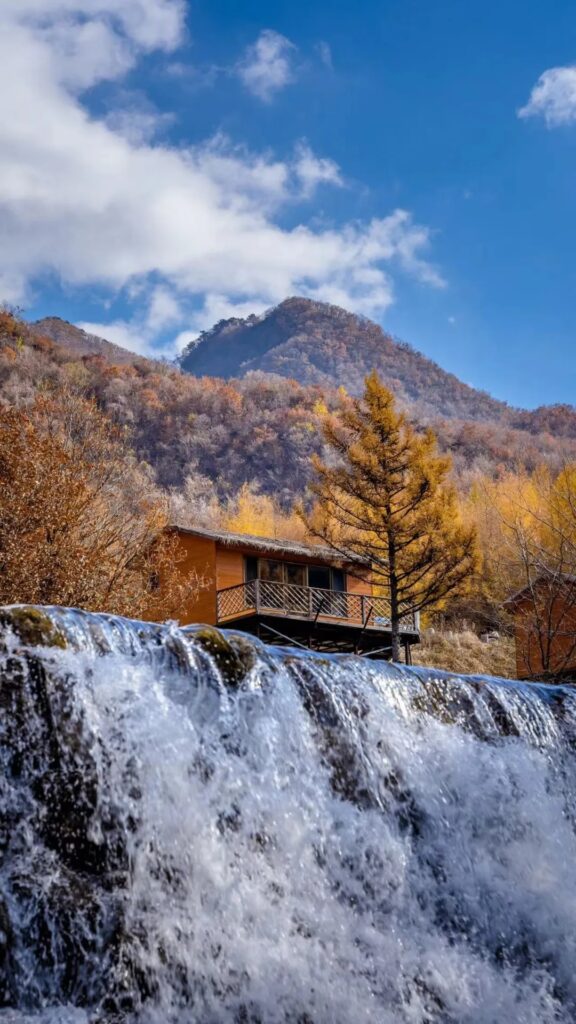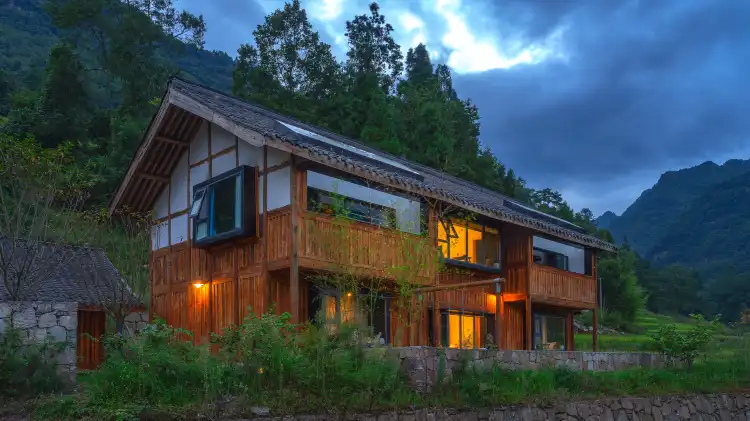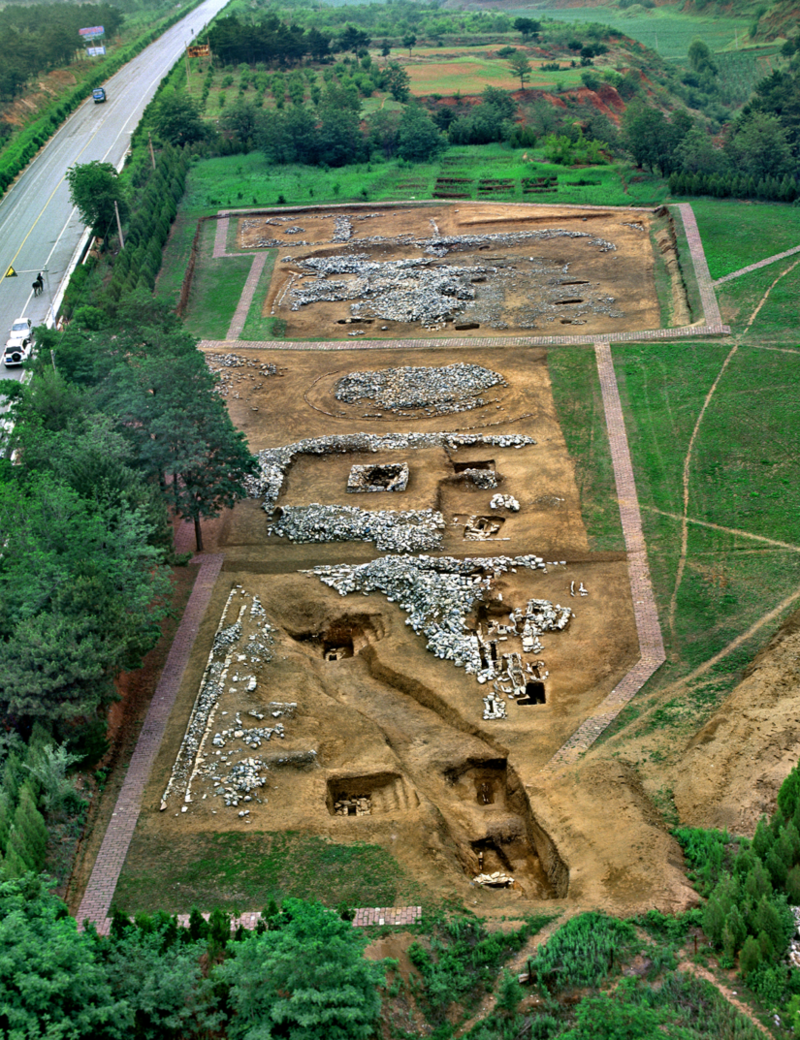Discover the Ancient Mysteries of Niuheliang Site: A Journey Through Time

An Essential Guide to Visiting Niuheliang_Site
Nestled in the breathtaking landscape of Northeast China, the Niuheliang Archaeological Site invites visitors to step back in time to the dawn of civilization. This remarkable site, which dates back approximately 5,500 to 6,000 years, is a centerpiece of the Hongshan culture, a civilization known for its intricate jade craftsmanship and spiritual practices. As you explore this ancient burial and sacrificial center, you will uncover fascinating remnants of a society that revered its ancestors and celebrated its beliefs through elaborate rituals.
The Niuheliang site is distinguished by its grand scale and exceptional preservation, featuring an array of archaeological remains, including the awe-inspiring Goddess Temple and numerous stone mounds that served as elaborate burial grounds. Each structure tells a story, from the sacred altars where offerings were made to the intricate graves that reflect the social hierarchies of early human communities. Here, you can witness the profound connection between the people of the Hongshan culture and their spiritual world.
Beyond its historical significance, Niuheliang offers a stunning natural setting, surrounded by the serene beauty of the Nuluerhu Mountains. The harmonious blend of history and nature provides an ideal backdrop for exploration and reflection. Whether you’re a history buff, a culture enthusiast, or simply someone seeking to experience the rich heritage of China, Niuheliang is an essential destination that promises to captivate your imagination. Prepare to embark on a journey through time, where the echoes of ancient rituals resonate amidst the whispers of the wind.
In This Guide
- An Essential Guide to Visiting Niuheliang_Site
- The Rich History and Legends of Niuheliang_Site
- Main Highlights: What You Absolutely Can’t Miss
- Planning Your Visit: A Practical Guide
- Tickets: Prices, Booking, and Tips
- How to Get There: A Complete Transportation Guide
- Local Cuisine and Accommodation Nearby
- Frequently Asked Questions
- Final Thoughts on Your Trip
The Rich History and Legends of Niuheliang_Site
Nestled between the rugged mountains of Northeast China, the Niuheliang Archaeological Site unveils a compelling narrative that stretches back over 5,000 years, painting a vivid picture of early human civilization. This ancient site, part of the rich tapestry of the Hongshan culture, serves as a poignant reminder of humanity’s quest for spirituality and social structure long before recorded history.
Discovered amidst the picturesque landscapes of Liaoning Province, Niuheliang is characterized by its unique geographical features, including mountain ridges and valleys that create a natural amphitheater for the sacred activities that once took place here. It is believed that the site functioned primarily as a burial and sacrificial center during the late Hongshan period, a time when the people of this region began to forge their identity through elaborate rituals and communal gatherings.
Archaeological excavations commenced in earnest in the early 1980s, revealing a complex network of structures, including the renowned Goddess Temple. This temple, with its semi-subterranean earth-wood construction, showcases a remarkable blend of architectural ingenuity and spiritual devotion. The temple ruins and surrounding sacrificial pits suggest that the site was not merely a place of worship but a vibrant hub where the community engaged in rituals that transcended the mundane, celebrating life, death, and the divine.
Among the most striking features of the Niuheliang site are the stone mounds, which serve as ancient burial grounds. These mounds vary in size and complexity, indicating a social hierarchy that existed within the community. The discovery of jade artifacts, intricately carved in the shapes of dragons, phoenixes, and humanoids, speaks to the artistry and cultural significance attributed to these objects. They were not just grave goods but symbols of status, belief, and the interconnectedness of life and afterlife.
Legends surrounding Niuheliang echo through the ages, suggesting that this was a place where the ancestors were revered and where the spirits of the departed were believed to watch over the living. The reverence for female figures, as evidenced by the clay statues uncovered in the Goddess Temple, hints at a matriarchal or goddess-worshipping society that celebrated feminine power and fertility.
Each artifact unearthed at Niuheliang adds a layer to the understanding of the Hongshan culture, a civilization that laid foundational stones for future Chinese dynasties. The site offers profound insights into the early agricultural practices, social organization, and spiritual beliefs of its inhabitants, illuminating a period when humanity began to make sense of its place in the cosmos.
Today, the Niuheliang Archaeological Site stands as a beacon for scholars and travelers alike, inviting those who visit to ponder the mysteries of the past. The echoes of rituals, the whispers of the ancestors, and the artistry of the jade relics create a palpable sense of history that lingers in the air. For international travelers seeking a deeper connection to the roots of civilization, Niuheliang offers a captivating journey into the heart of ancient China, where history and legend intertwine seamlessly.

Niuheliang_Site.
Main Highlights: What You Absolutely Can’t Miss
Exploring the Niuheliang Archaeological Site offers a captivating glimpse into one of the earliest centers of human civilization in Northeast Asia. Here are the main highlights that you absolutely cannot miss during your visit:
The Goddess Temple
At the heart of the Niuheliang site lies the revered Goddess Temple, a semi-subterranean structure that serves as a testament to the spiritual beliefs of the Hongshan culture. This temple complex features interconnected chambers and is surrounded by sacrificial pits, hinting at the rituals performed here. Visitors can marvel at intricately crafted clay figures, including a notable life-size statue with feminine attributes, believed to represent ancestral worship. The temple’s design and its artifacts provide insight into the early forms of religious practice, making it an essential stop for understanding the cultural significance of the site.
The Stone Mounds
A unique feature of the Niuheliang site, the stone mounds serve as a cluster of prehistoric burial sites. With varying sizes and intricate structures, these mounds reveal the social hierarchy of the Hongshan people. Notably, the central grave stands out with its impressive stone coffin filled with exquisite jade artifacts, symbolizing the status of its occupant. Visitors will find it fascinating to explore the four categories of graves and the distinct burial practices that suggest a rich jade culture and a complex belief system surrounding death and the afterlife.
The Sacrificial Altars
Adjacent to the stone mounds are the sacrificial altars, two of which have been unearthed at the site. The round and square altars represent early forms of worship practices that would evolve in Chinese civilization. The design of the altars, featuring concentric circles of standing stones and carefully arranged pottery, reflects a sophisticated understanding of ritual space. Observing these altars allows travelers to appreciate the spiritual architecture that laid the groundwork for future religious practices in China.
Natural Setting and Scenic Views
Nestled in a breathtaking landscape characterized by the Nuluerhu Mountains, the Niuheliang site offers not only historical significance but also stunning natural beauty. With altitudes ranging from 550 to 680 meters, the site presents panoramic views of the surrounding valleys and ridges. Take a moment to bask in the serene environment that once served as a sacred ground for ancient rituals, enhancing your connection to the past.
Archaeological Significance
The Niuheliang site is recognized as a pivotal archaeological location that has shed light on the Hongshan culture, which dates back 5,500 to 6,000 years. As the largest and best-preserved site of its kind, it provides invaluable insights into the social structures, lifestyles, and beliefs of early Chinese civilizations. Engaging with the artifacts and remains unearthed here can deepen your understanding of how these ancient peoples lived, worked, and worshipped.
Visiting the Niuheliang Archaeological Site is not just a journey into the past; it’s an exploration of the roots of human civilization in Northeast Asia. Make sure to take your time at each highlight, as they collectively weave a rich narrative of a culture that has significantly influenced the course of history.

Niuheliang_Site.
Planning Your Visit: A Practical Guide
Visiting the Niuheliang Archaeological Site offers a unique glimpse into the ancient Hongshan culture, a civilization that thrived in Northeast China over 5,000 years ago. Here’s everything you need to know to make the most of your visit to this fascinating location.
Getting There
Location: The Niuheliang Archaeological Site is situated in Chaoyang City, Liaoning Province, China, at the border of Lingyuan City and Jianping County. The coordinates are approximately N 41°16′15″, E 119°27′9″.
Transportation:
– By Air: The nearest major airport is Shenyang Taoxian International Airport (SHE), approximately 250 kilometers away. From there, you can hire a car or take a bus to Chaoyang City.
– By Train: Chaoyang has a train station with connections to major cities in China. Once in Chaoyang, local transport options like taxis or buses can take you closer to the site.
– By Bus: Long-distance buses also operate from various cities directly to Chaoyang, making it accessible for international travelers.
Best Time to Visit
The ideal time to visit the Niuheliang site is during the spring (April to June) and autumn (September to November) months when the weather is mild and pleasant. Summer can bring intense heat, while winters can be quite cold, which may not be ideal for exploring outdoor archaeological sites.
What to Expect
Niuheliang is a treasure trove of archaeological wonders. As you explore, expect to see:
- The Goddess Temple: This semi-subterranean structure is believed to be one of the earliest sacrificial temples discovered in Northeast Asia. Look out for the beautifully crafted clay figures and animal sculptures.
- Stone Mounds and Graves: The site features various stone mounds where ancient graves can be found. These graves, particularly the central grave, showcase intricate jade artifacts, reflecting the social hierarchies of the time.
- Sacrificial Altars: Two main altars, a round and a square one, give insight into the ceremonial practices of the Hongshan culture. Their unique construction is emblematic of early religious architecture in the region.
Visitor Facilities
While the site itself is primarily archaeological, there are facilities to enhance your experience:
- Visitor Center: Check out the visitor center for maps, guides, and educational materials. Knowledgeable staff can offer insights into the significance of the site.
- Guided Tours: Consider joining a guided tour for a deeper understanding of the culture and history. Many tours include transportation from Chaoyang and knowledgeable guides.
- Rest Areas: There are designated areas where you can take a break, enjoy a snack, or simply soak in the stunning views of the surrounding mountains.
Tips for Your Visit
- Wear Comfortable Shoes: The terrain can be uneven, and you’ll likely be walking a lot, so comfortable footwear is essential.
- Bring Water and Snacks: While there may be some facilities, it’s wise to carry your own water and perhaps a light snack, especially if you plan to spend several hours exploring.
- Photography: The site offers incredible photo opportunities, so don’t forget your camera! Just be sure to respect any posted signs regarding photography restrictions.
- Respect the Site: As a UNESCO World Heritage site, it’s important to follow all guidelines to preserve this invaluable cultural heritage. Stay on marked paths and avoid touching artifacts.
Cultural Etiquette
When visiting the site, it’s important to be respectful of the local culture. This includes dressing modestly, keeping noise to a minimum, and being courteous to any guides or staff you interact with.
Nearby Attractions
If you have time, consider exploring the following nearby sites to enrich your experience:
- Hongshanhou Archaeological Site: Just a short distance away, this site offers more insights into the Hongshan culture and its residential patterns.
- Weijiawopu Archaeological Site: Another significant site that showcases the daily life and social structure of the Hongshan people.
- Local Cuisine: Don’t miss out on tasting local dishes in Chaoyang, which can provide a delightful culinary experience after your archaeological exploration.
Your visit to the Niuheliang Archaeological Site promises to be a captivating journey into the past, offering a rich tapestry of history, culture, and ancient mysteries waiting to be uncovered. Enjoy your adventure!

Niuheliang_Site.
Tickets: Prices, Booking, and Tips
Visiting the Niuheliang Archaeological Site is like stepping back in time to explore one of the most significant cultural landmarks of ancient China. Here’s everything you need to know about tickets, pricing, and tips for making the most of your visit.
Ticket Prices
- General Admission: The entrance fee for the Niuheliang Archaeological Site is approximately 60 CNY (around 9 USD). This fee grants you access to the main site and its various archaeological features.
- Students & Seniors: Reduced ticket prices are often available for students and seniors, typically around 30 CNY (about 4.50 USD). It’s advisable to carry an ID for verification.
- Children: Entry may be free or discounted for children under a certain age, usually 12, so check local guidelines when planning your trip.
Booking Information
- Advance Booking: While tickets can generally be purchased at the site, it’s a good idea to book online in advance, especially during peak tourist seasons. Check local travel websites or the official site of the Niuheliang Archaeological Site for available online booking options.
- Group Discounts: If you’re traveling with a group, inquire about potential discounts for larger parties. Group rates may vary, so it’s best to contact the site directly.
Tips for Your Visit
-
Best Time to Visit: The ideal time to visit Niuheliang is during the spring (April to June) and autumn (September to November) when the weather is mild and the surrounding landscapes are particularly scenic.
-
Guided Tours: Consider joining a guided tour for a more in-depth understanding of the site’s rich history. Local guides can provide valuable insights into the archaeological finds and the significance of the Hongshan culture.
-
What to Bring: Wear comfortable shoes as you may do quite a bit of walking on uneven terrain. Bring sunscreen, a hat, and water, especially during the warmer months.
-
Photography: Photography is usually permitted, but be respectful of any specific guidelines regarding flash or tripods. Capture the stunning vistas and the intricate details of the archaeological structures.
-
Explore the Surroundings: After touring the site, take some time to explore the beautiful natural surroundings. The Nuluerhu Mountains offer a picturesque backdrop and are perfect for a leisurely hike.
-
Cultural Sensitivity: Remember that this site is of great cultural significance. Be mindful of your surroundings, and observe any rules or restrictions in place to preserve the integrity of the archaeological remains.
By planning ahead and following these tips, your visit to the Niuheliang Archaeological Site will be both enjoyable and enriching. Enjoy your journey through this fascinating chapter of ancient Chinese civilization!
How to Get There: A Complete Transportation Guide
Reaching the Niuheliang Archaeological Site, a significant cultural landmark in China, involves navigating through a blend of local transportation options and scenic landscapes. Located near the border of Lingyuan City in Liaoning Province, this UNESCO Tentative Listed site is best accessed from major urban centers. Here’s your complete transportation guide to ensure a smooth journey.
Getting to Niuheliang Archaeological Site
By Air
The nearest major airport to Niuheliang is Shenyang Taoxian International Airport (SHE), located approximately 300 kilometers away. From the airport, you have a couple of options:
- Domestic Flights: For travelers coming from other parts of China, consider flying into Shenyang and then taking a bus or train to Chaoyang City.
- Airport Transfers: You can arrange for a taxi or a ride-hailing service from the airport to the city center of Shenyang, where you can catch further transport to Niuheliang.
By Train
From Shenyang, you can take a train to Chaoyang City. This city serves as the most convenient hub for visitors heading to the Niuheliang site.
- Train Services: The journey takes about 2 to 3 hours, depending on the train type. High-speed trains are available, making the trip quick and comfortable.
- Train Station: Upon arrival at Chaoyang Railway Station, you can find local transportation options to continue your journey.
By Bus
From Chaoyang Railway Station, the next step is to reach Lingyuan City, which is much closer to the Niuheliang site.
- Buses to Lingyuan: Regular bus services run from Chaoyang to Lingyuan, taking approximately 1 to 1.5 hours.
- Local Transport: Once in Lingyuan, you can take a taxi or a local minibus directly to the Niuheliang site. The site is roughly a 30-minute drive from the city center.
By Car
For those who prefer the flexibility of self-driving, renting a car is a viable option. The drive from Shenyang to Niuheliang takes approximately 4 to 5 hours, depending on traffic.
- Route: The most direct route is via G1 (the Jingha Expressway) towards Chaoyang, and then following local signs to Lingyuan and subsequently to the Niuheliang site.
- Navigation: GPS services are reliable in this region, making navigation straightforward.
Local Considerations
- Best Time to Visit: Spring and autumn are ideal for visiting, as the weather is mild and pleasant.
- Local Guides: Consider hiring a local guide at the site to gain deeper insights into the rich history and significance of the Niuheliang Archaeological Site.
- Accessibility: Be prepared for some hiking, as the site is located in a hilly area.
With this transportation guide in hand, you’re all set to explore the historical marvels of the Niuheliang Archaeological Site, where ancient beliefs and cultures come to life amidst breathtaking natural scenery. Safe travels!

Niuheliang_Site.
Local Cuisine and Accommodation Nearby
When visiting the Niuheliang Archaeological Site, you’ll not only be immersed in the rich history of the Hongshan culture but also have the opportunity to savor local culinary delights and find comfortable accommodations nearby.
Culinary Delights
Local Cuisine:
The region surrounding Niuheliang is known for its hearty and rustic cuisine, heavily influenced by the agricultural practices and natural resources of Liaoning Province. Here are a few dishes you must try:
-
Liaoning-style Dumplings (Jiaozi): These delightful dumplings are a staple in the region, often filled with fresh vegetables, minced meat, or seafood. They are usually boiled or steamed and served with a tangy soy sauce or vinegar dip.
-
Braised Pork with Soy Sauce (Hong Shao Rou): This tender dish features pork belly cooked slowly in a mixture of soy sauce, sugar, and spices, resulting in a rich and savory treat that locals adore.
-
North China Noodles: You can find various noodle dishes, from hand-pulled to wheat-based varieties, often served in hearty broths with seasonal vegetables and proteins.
-
Baked Buns (Shaobing): These flaky, sesame-topped buns are a popular snack or breakfast item. They can be filled with sweet or savory ingredients and are perfect for on-the-go eating.
Dining Recommendations
For a taste of local flavors, consider dining at these nearby restaurants:
-
Niuheliang Dining Hall: Located just a short drive from the archaeological site, this restaurant specializes in local cuisine, particularly dumplings and noodle dishes. The cozy atmosphere and friendly staff make it a great spot to relax after a day of exploration.
-
Liaoning Folk Cuisine Restaurant: This venue offers a broader selection of traditional Liaoning dishes, including their famous braised pork and various seasonal specialties. The restaurant is known for its warm ambiance and hospitable service.
Comfortable Stays
After a day spent uncovering the secrets of the Hongshan culture, you’ll want a comfortable place to rest. Here are some accommodation options to consider:
-
Niuheliang Hotel: Located conveniently close to the archaeological site, this hotel offers modern amenities, comfortable rooms, and a restaurant serving local cuisine. It’s an excellent choice for travelers looking for convenience and comfort.
-
Chaoyang City Guesthouse: A bit further afield in Chaoyang City, this guesthouse offers a more intimate stay with personalized service. The rooms are cozy, and the location provides easy access to local attractions and eateries.
-
Chifeng Holiday Inn: Situated in Chifeng, this hotel is slightly farther from Niuheliang but offers fantastic facilities, including a fitness center and a restaurant with a diverse menu. It’s perfect for those who want a touch of luxury after a day of exploration.
-
Local Homestays: For a more immersive experience, consider staying at one of the local homestays. These often offer traditional meals prepared by your hosts and a unique insight into the local way of life.
Conclusion
Exploring the Niuheliang Archaeological Site not only introduces you to the ancient Hongshan culture but also invites you to indulge in the authentic flavors and comfortable accommodations of the region. Don’t miss the chance to enrich your travel experience with local cuisine and hospitality during your visit!

Niuheliang_Site.
Frequently Asked Questions
Frequently Asked Questions about Niuheliang Archaeological Site
1. Where is the Niuheliang Archaeological Site located?
The Niuheliang Archaeological Site is situated on the border of Lingyuan City, Jianping County, and Harqin Left Wing Mongol Autonomous County, in Liaoning Province, China. It lies in a picturesque mountainous region between the Mongolian Plateau and the North China Plain.
2. What is the significance of the Niuheliang site?
Niuheliang is one of the most important archaeological sites of the Hongshan culture, dating back 5,500 to 5,000 years. It served as a burial and sacrificial center and is known for its impressive scale, well-preserved structures, and the rich variety of cultural relics discovered there. This site provides valuable insights into early human civilization in Northeast Asia.
3. What can I expect to see at the site?
Visitors can explore various archaeological features, including the Goddess Temple, stone mounds, and sacrificial altars. The site showcases an array of artifacts, such as intricately crafted jade objects and clay figures, which reveal the beliefs and practices of the Hongshan culture.
4. Is there an entry fee to visit the Niuheliang Archaeological Site?
While specific fees may vary, many archaeological sites in China typically charge a modest entry fee. It’s advisable to check local resources or visitor centers for the most current information on admission costs.
5. Are there guided tours available?
Yes, guided tours are often available at the Niuheliang site. These tours provide in-depth information about the archaeological findings and cultural significance, enriching your experience. Consider booking a tour in advance for a more comprehensive visit.
6. What is the best time to visit the Niuheliang site?
The ideal time to visit is during the spring (April to June) and autumn (September to November) when the weather is mild and pleasant. Summer can be hot, and winter temperatures can drop significantly, so plan accordingly based on your comfort preferences.
7. How do I get to the Niuheliang Archaeological Site?
The site is accessible by car or public transport from nearby cities such as Chaoyang or Chifeng. If you’re traveling from major cities, consider taking a train or bus to these hubs and then hiring a local taxi or joining a tour group for the final leg of your journey.
8. Are there facilities available for visitors at the site?
Basic visitor facilities may be available, including restrooms and informational signage. However, it’s wise to bring water, snacks, and any other essentials, as amenities may be limited on-site.
Final Thoughts on Your Trip
As you reflect on your journey to the Niuheliang Archaeological Site, let the echoes of history resonate within you. This remarkable location is not just a collection of ancient structures but a testament to the ingenuity and spirituality of the Hongshan culture, which flourished over 5,000 years ago. Walking among the remnants of the Goddess Temple and the intricate stone mounds, you are stepping into a world where ancestral veneration and ritual sacrifice were woven into the fabric of daily life.
The grandeur of the site, with its well-preserved artifacts and profound cultural significance, invites you to ponder the complexities of early human civilization in Northeast Asia. As you gaze upon the exquisite jade relics and the monumental altars, consider the stories they tell of a society that revered nature and the divine, a society that laid the groundwork for future civilizations.
Your visit to Niuheliang is not merely a sightseeing endeavor; it is a pilgrimage into the heart of China’s rich archaeological heritage. Take with you the inspiration drawn from this ancient sacred landscape, and carry the spirit of discovery as you continue your travels. Each step you take in this historic site connects you with the past, enriching your understanding of humanity’s shared journey through time.